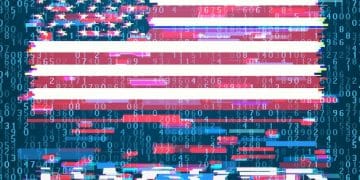US Immigration Policy Changes: Employer’s Guide for Hiring in 2025

US Immigration Policy Changes significantly impact hiring practices. Employers must understand potential shifts in visa programs, compliance requirements, and enforcement priorities to effectively navigate hiring in 2025 and maintain a legal and productive workforce.
Navigating the complexities of **US Immigration Policy Changes: What Employers Need to Know for Hiring in 2025** requires a proactive approach. Staying informed about evolving regulations is crucial for maintaining a compliant and competitive workforce.
Understanding the Current US Immigration Landscape
The US immigration system is a dynamic framework, shaped by legislative actions, executive orders, and court decisions. Employers need to be aware of the current state of immigration laws to anticipate future changes.
Key Immigration Laws and Regulations
Several key laws and regulations form the foundation of US immigration policy. These laws govern who can enter the country, how long they can stay, and what activities they can engage in while here.
- Immigration and Nationality Act (INA): This act is the cornerstone of US immigration law, setting out the basic rules for immigration to the United States.
- H-1B Visa Program: This program allows US employers to temporarily employ foreign workers in specialty occupations that require theoretical or technical expertise.
- Labor Condition Applications (LCAs): Employers seeking to hire foreign workers on H-1B visas must first obtain a certified LCA from the Department of Labor.
Staying abreast of these laws and regulations is vital for employers who rely on foreign talent.
Recent Policy Shifts and Their Impact
Recent years have seen significant shifts in US immigration policy. These changes have affected various aspects of the immigration system, from visa processing to enforcement priorities.

- Increased Scrutiny of Visa Applications: Visa applications are subject to increased scrutiny, leading to longer processing times and higher denial rates.
- Emphasis on Enforcement: The government has placed a greater emphasis on enforcing immigration laws, including worksite enforcement actions.
- Changes to DACA: The Deferred Action for Childhood Arrivals (DACA) program has faced legal challenges, creating uncertainty for employers who employ DACA recipients.
Understanding these policy shifts is crucial for employers who want to remain compliant and avoid potential legal issues.
In conclusion, being well-informed about the current US immigration landscape, including key laws, regulations, and recent policy shifts, is essential for employers navigating hiring practices.
Anticipating Immigration Policy Changes in 2025
Predicting the future of immigration policy is challenging, but understanding potential trends and developments is key to planning for 2025. Several factors could influence the direction of immigration policy in the coming years.
Potential Legislative Actions
Legislative action in Congress could bring significant changes to US immigration policy. Comprehensive immigration reform has been debated for years, but reaching a consensus has proved difficult.
One potential scenario is the passage of legislation that would create a pathway to citizenship for undocumented immigrants. Another possibility is legislation that would reform the H-1B visa program.
Executive Actions Under a New Administration
Executive actions by the President can also have a significant impact on immigration policy. A new administration could reverse or modify existing policies and implement new ones.
For example, a new administration could change enforcement priorities, alter visa processing procedures, or modify DACA. Employers should be prepared for potential changes in these areas.

Economic and Geopolitical Factors Influencing Policy
Economic and geopolitical factors can also influence immigration policy. Economic downturns can lead to increased calls for stricter immigration controls, while labor shortages can create pressure to ease immigration restrictions.
Geopolitical events, such as conflicts or natural disasters, can also affect immigration policy by creating refugee flows or disrupting migration patterns.
In summary, employers should stay informed about potential legislative actions, executive actions, and economic/geopolitical factors to anticipate immigration policy changes in 2025.
Impact of Policy Changes on Hiring Practices
Changes in immigration policy can have a direct impact on hiring practices. Employers need to be aware of these potential impacts to ensure compliance and maintain a productive workforce.
Visa Availability and Processing Times
Changes in visa availability and processing times can affect employers’ ability to hire foreign workers. Visa quotas may be reduced, or processing times may be lengthened, making it more difficult to bring in needed talent.
Employers may need to adjust their hiring timelines and explore alternative visa options to navigate these challenges.
Compliance Requirements for Employers
Immigration policy changes can also affect compliance requirements for employers. Employers may need to update their I-9 verification procedures, conduct internal audits, or provide additional training to their staff.
- I-9 Verification: Employers must verify the identity and employment eligibility of all new hires using Form I-9.
- E-Verify: Some employers are required to use E-Verify, an online system that compares employee information to government records to confirm employment eligibility.
- Worksite Enforcement: Employers need to be prepared for potential worksite enforcement actions by immigration authorities.
It is crucial for employers to stay up-to-date on these compliance requirements to avoid potential penalties.
Potential for Increased Enforcement
A shift towards increased enforcement can create uncertainty for employers, particularly those who employ undocumented workers. Employers may face increased scrutiny and the risk of fines or other penalties.
Employers should review their hiring practices to ensure compliance with immigration laws and consider conducting an internal audit to identify and address any potential issues.
In conclusion, employers need to be aware of the impact of immigration policy changes on visa availability, compliance requirements, and enforcement to maintain a compliant and productive workforce.
Strategies for Adapting to Changing Policies
Adapting to changing immigration policies requires a proactive and strategic approach. Employers can take several steps to mitigate the potential impact of policy changes and ensure continued access to talent.
Staying Informed About Policy Updates
Staying informed about policy updates is the first step in adapting to changing immigration policies. Employers should monitor relevant government websites, subscribe to industry newsletters, and consult with immigration attorneys to stay abreast of the latest developments.
Regularly reviewing internal policies and procedures is also essential to ensure compliance with current regulations.
Developing Contingency Plans
Developing contingency plans can help employers prepare for potential disruptions caused by immigration policy changes. These plans should address issues such as visa delays, increased enforcement, and changes to DACA.
For example, employers could identify alternative sources of talent, develop training programs for existing employees, or explore remote work options.
Working with Legal Counsel
Working with experienced immigration attorneys is crucial for navigating the complexities of the immigration system. Attorneys can provide guidance on compliance, visa options, and enforcement defense.
Attorneys can also help employers develop strategies for attracting and retaining foreign talent in a changing policy environment.
In summary, to adapt to changing policies, employers should stay informed, develop contingency plans, and work closely with legal counsel to navigate the immigration landscape.
Best Practices for Hiring Foreign Nationals in 2025
Hiring foreign nationals requires a nuanced approach that balances compliance with business needs. Employers can follow several best practices to ensure a smooth and successful hiring process.
Ensuring Legal Compliance
Ensuring legal compliance is paramount when hiring foreign nationals. Employers should verify the identity and employment eligibility of all new hires using Form I-9 and comply with all applicable immigration laws and regulations.
- Accurate I-9 Verification: Ensure accurate and thorough completion of Form I-9 for all new hires.
- E-Verify Compliance: If required, enroll in and use E-Verify to confirm employment eligibility.
- Regular Audits: Conduct regular internal audits to identify and address any potential compliance issues.
Employers should also consult with immigration attorneys to ensure they are fully compliant with all applicable laws and regulations.
Attracting and Retaining Talent
Attracting and retaining foreign talent requires a competitive compensation package and a supportive work environment. Employers should offer competitive salaries, benefits, and opportunities for professional development.
Creating a welcoming and inclusive workplace can also help attract and retain foreign talent. Employers should provide language training, cultural awareness programs, and mentoring opportunities.
Supporting the Visa Sponsorship Process
Supporting the visa sponsorship process is another way to attract and retain foreign talent. Employers should provide assistance with visa applications, extensions, and renewals.
Employers should also be willing to advocate for their foreign employees and provide support in navigating the immigration system.
In conclusion, following best practices for ensuring compliance, attraction/retention, and visa processes is vital for successfully hiring foreign nationals.
Resources for Employers
Numerous resources are available to help employers navigate the complexities of US immigration policy. These resources can provide valuable information, guidance, and support.
Government Agencies
Several government agencies oversee various aspects of immigration policy. Employers can consult these agencies for information on visa programs, compliance requirements, and enforcement actions.
- USCIS: The US Citizenship and Immigration Services (USCIS) is responsible for processing visa applications and adjudicating immigration benefits.
- DOL: The Department of Labor (DOL) oversees labor standards and employment-based immigration programs.
- ICE: The Immigration and Customs Enforcement (ICE) is responsible for enforcing immigration laws and conducting worksite enforcement actions.
Employers should regularly visit these agencies’ websites for updates and guidance.
Industry Associations
Industry associations can also provide valuable resources for employers. These associations often offer training programs, publications, and advocacy efforts related to immigration policy.
Participating in industry associations can help employers stay informed and connect with other employers facing similar challenges.
Legal and Consulting Services
Legal and consulting services can provide expert guidance and support to employers navigating the immigration system. Immigration attorneys can provide advice on compliance, visa options, and enforcement defense.
Consulting firms can help employers develop and implement immigration policies and procedures.
In summary, employers can use government agencies, industry associations, and legal/consulting services to navigate complex immigration policies.
| Key Point | Brief Description |
|---|---|
| 🔑 Policy Changes | Stay updated on visa rules, compliance, and enforcement. |
| 💼 Hiring Practices | Adapt hiring to meet immigration laws and visa requirements. |
| 🛡️ Compliance | Ensure I-9, E-Verify, and workplace law compliance. |
| 🤝 Resources | Use agencies, associations, and legal services for guidance. |
Frequently Asked Questions (FAQ)
▼
The main factors include economic conditions, national security concerns, demographic shifts, and political ideologies, all influencing the laws and regulations surrounding immigration.
▼
Employers should conduct regular internal audits of their I-9 forms, ensure compliance with E-Verify (if applicable), and train staff on proper hiring procedures to mitigate risk.
▼
Employers should consult with an immigration attorney to understand their legal obligations and potential liabilities, and develop a plan for addressing the situation, balancing legal and ethical considerations.
▼
The USCIS website, immigration attorneys, and industry associations offer guidance on H-1B visa requirements, application procedures, and compliance issues, ensuring employers are well-informed.
▼
Offering language training, cultural awareness programs, mentoring, and promoting diversity can create an inclusive workplace, supporting the integration and success of foreign national employees.
Conclusion
In conclusion, understanding and adapting to **US Immigration Policy Changes: What Employers Need to Know for Hiring in 2025** is crucial for maintaining legal compliance and a competitive workforce. By staying informed and proactive, employers can navigate the complexities of the immigration system and ensure their continued success.





